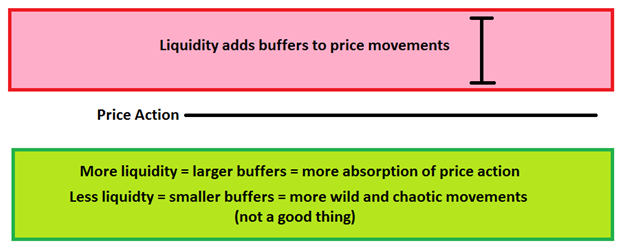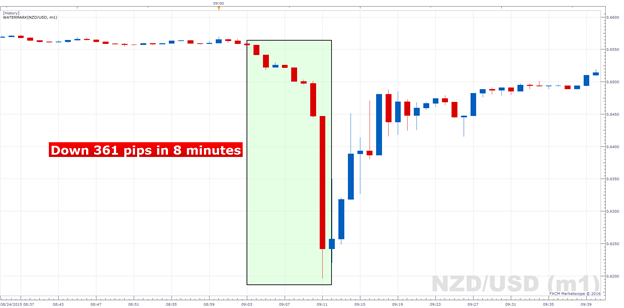This article is the second in a six article series on risks when trading extremely volatile market conditions. See the end of this article for links to other parts in the series.
Liquidity is the ability of a valued item to be transferred into currency on demand. This essentially implies you are able to get out of an investment without taking a hit on the price.
Imagine BigBox-Mart is having a super sale on a specific type of television. BigBox-Mart is open 24 hours per day, but when you enter the store, the TV’s on sale are gone. This is a crude example of liquidity, or rather lack of liquidity for the TV’s.
My colleague James Stanley provides great detail on the deconstruction of liquidity. He states that “a very liquid market will have considerably more (and larger) buffers than a less liquid market, as there are sitting stop and limit orders above and below current price action that can absorb buying or selling pressure should an event create a price movement in a market.”

Taken from “How to Avoid a Liquidity Trap” authored by James Stanley
During times of extreme volatility, the liquidity can dry up creating erratic market movements without a lot of depth in the market near the current price levels. For a trader who is sitting on a large position, getting out of that position in one ticket near the current price level is less likely during highly volatile conditions. Illiquid markets lead to slippage on smaller orders and an inability or possible delay in exiting for larger orders. This delay and slippage results from a freezing market where participants are not actively offering a large supply of product.
A recent example of this was on New Zealand Dollar in August 2015. As the equity markets were crashing, the banks became risk averse and pulled in their NZD quotes. As the banks pulled in their quotes, liquidity evaporated. As a result, the NZD/USD exchange rate dropped 361 pips in the span of 8 minutes. Within 6 minutes later, the banks restored some of their quoting and the NZDUSD exchange rate faded the move higher 285 pips.

Chart prepared by Jeremy Wagner
For somebody who was already in a NZD/USD trade when this market dried up on August 24, 2015, they may have experienced a lot of pain via slippage while trying to exit or manage the trade. That is why having a buffer in your account in usable margin is paramount. The larger buffer would potentially allow a trader more wiggle room to withstand the large market movement relative to another trader with less usable margin.
The trader with less usable margin runs the risk of a margin call which initiates a market order. The next best available price could be many pips away which is how a negative balance can be incurred.
Some traders like to use a margin call as a stop loss, but that behavior opens the door and invites the potential for losses larger than the trader’s deposit.
For traders who are seeking to initiate a new position during an illiquid environment, carefully consider the pain that may be incurred once you are in the market. It may be better off to avoid the exposure until market conditions calm down. Otherwise, steer towards market that tend to be more liquid and stay away from exotic markets that typically have less liquidity. Markets that tend to be more liquid include EURUSD, USDJPY, and GBPUSD. Exotic markets such as ZAR, HUF, CZK may see an imbalance of trading on the bid and ask which could make it difficult to trade.
Also, maintaining low amounts of leverage may lower the risk of a margin call relative to another trader with higher amounts of leverage. We studied over 12 million live trades and found that when traders implemented less than 10x effective leverage, the pool of traders showed a greater percentage of profitable traders. In fact, for those traders implementing less than 5x effective leverage, the percentage of profitable traders was 40% compared to 17% of traders using more than 25x leverage.
Remember that trading on margin can result in losses that could exceed your deposited funds and therefore may not be suitable for everyone, so please ensure that you fully understand the high level of risk involved.
This article is part 2 of a 6 article series on risks during extremely volatile market environments. Continue on and read part 3.
See Jeremy’s recent articles at his Bio Page.






